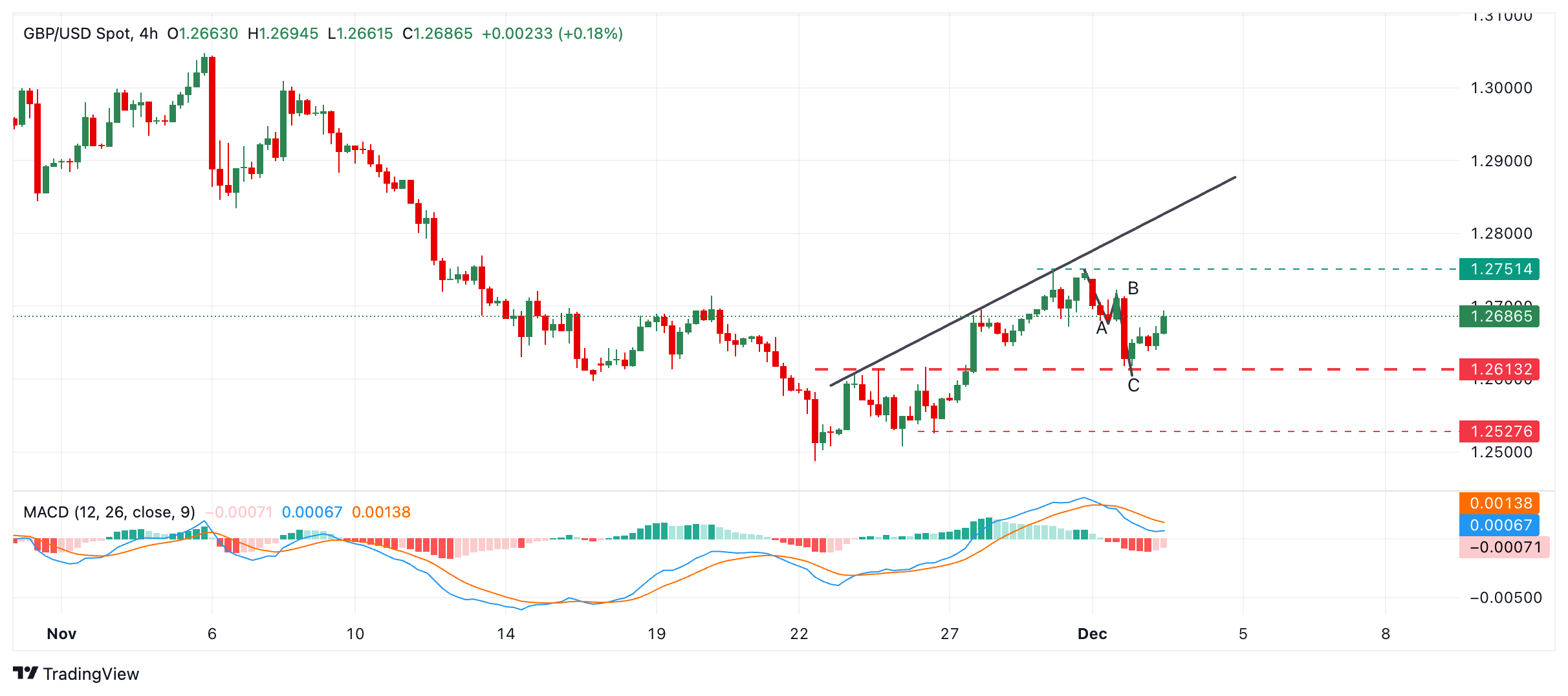Pound Sterling rebounds against US Dollar after reversal in sentiment

- The Pound Sterling is rebounding against the US Dollar as sentiment switches for GBP’s transatlantic currency peer.
- Weak UK data may limit the Pound’s gains, however, as data shows UK shoppers shy away from spending in November.
- Technically, GBP/USD hangs onto its short-term uptrend but remains vulnerable to a reversal.
The Pound Sterling (GBP) climbs back up into the 1.2660s on Tuesday as market sentiment switches against the US Dollar (USD).
GBP/USD’s recovery comes after the pair suffered heavy losses on the previous day and declined by 0.71%. This followed tough talk from US President-elect Donald Trump in which he threatened to hit the BRICS trading bloc with 100% tariffs unless it gave up its search for an alternative to the US Dollar. Stronger-than-expected US Purchasing Manager Index (PMI) data further boosted the Buck.
However, it was comments from Federal Reserve (Fed) members, including Fed Governor Christopher Waller, that eventually capped the Greenback’s rally on Monday.
Waller said he was leaning “toward supporting a cut in December.” This solidified bets for the Fed cutting interest rates by 25 basis points at its December policy meeting, with the CME FedWatch tool calculating a probability of 76% (from the mid 60s previously). Lower interest rates are negative for currencies as they reduce foreign capital inflows.
Pound Sterling fails to capitalize due to weak fundamentals
The Pound Sterling has struggled to capitalize on the US Dollar’s “fumble” as UK data disappoints. On Monday, the final reading of the UK PMI in November surprised to the downside, with the Manufacturing PMI falling to a nine-month low of 48.0, from 49.9 in October and below the flash estimate of 48.6.
On Tuesday, the British Retail Consortium’s (BRC) Like-for-Like Retail Sales data provides no relief either. The BRC’s release shows shoppers tightening their belts with a surprise 3.4% drop in sales in November after a 0.3% gain in October, and well below the 0.7% rise expected.
The data adds weight to the view that the Bank of England (BoE) will likely lower interest rates at its December meeting. As such, GBP/USD’s dead-cat bounce looks frail.
Pound Sterling suffers from French contagion
The Pound Sterling has not been spared the malaise emanating from across the channel, either, with UK government bonds (Gilts) selling off after the news that French Prime Minister (PM) Michel Barnier’s minority government will face a vote of no confidence by opposition parties opposed to his Budget bill.
The news widened the spread of 10-year Gilt yields over German Bunds to its widest “since Liz Truss was PM, closing at 221.5 bps yesterday,” said Deutsche Bank’s head of macro research Jim Reid in a note on Tuesday morning.
Reid goes on to explain the process that will now unfold for the French government in his note.
“In terms of what happens next, we’re in territory that hasn’t been seen in a long time, as the last successful no-confidence motion was in 1962,” says Reid, adding, “That vote is likely to take place this week, possibly as soon as Wednesday, and assuming it’s successful, that would force the government’s resignation. In the short term, the government can remain in office as a caretaker government.”
New elections will not take place until the summer, however, as the French Constitution requires a one-year wait until another dissolution can take place.
In the meantime, French President Emmanuel Macron will have to propose a new PM, “which could in theory be Barnier again, but there’s no reason to think a new government would be any more stable, given how fractured the National Assembly is,” says Reid.
Regarding the ill-fated Budget, French lawmakers will probably approve a special law authorising the government to collect existing taxes, which it could spend “by decree”.
“However, this would only permit public spending that was part of the 2024 budget, rather than additional expenditures,” adds the strategist.
On the radar
As far as market-moving data for GBP/USD is concerned, the main focus for traders will be US JOLTS jobs data on Tuesday and Fed speakers, including San Francisco Fed President Mary Daly, Fed Governor Adriana Kugler, and Chicago Fed President Austan Goolsbee.
Technical Analysis: Recovers after ABC correction
GBP/USD recovers into the 1.2680s on Tuesday. Monday’s sell-off could be characterized as a three-wave ABC correction which would mean the pair’s short-term uptrend from the November 22 lows remains intact, albeit by a thread.
Yet, since it is a principle of technical analysis that “the trend is your friend,” the odds continue to favor an extension of this uptrend.
GBP/USD 4-hour Chart
A break above 1.2750 would probably activate the next upside target at around 1.2824, where the (green) 200-period Simple Moving Average (SMA) is situated.
A break below the key support level and the bottom of the ABC correction (thick red dashed line) at 1.2617 would confirm a reversal of the short-term trend. This would likely lead to an extension down to support at 1.2527 followed by 1.2487, the November 22 lows.
The blue Moving Average Convergence Divergence (MACD) indicator has crossed below its red signal line, suggesting more weakness to come.
Although the short-term trend is up, the medium-term trend is still bearish, indicating a risk to the downside if this time frame cycle takes over. To make matters more complicated, the longer-term trend – it could be argued – is still probably bullish.
Economic Indicator
BRC Like-For-Like Retail Sales (YoY)
The British Retail Consortium (BRC) Like-For-Like Retail Sales measures changes in the actual value of retail sales from participating companies with invaluable management information on a regular and reliable basis. It shows the performance of the retail sector. A high reading is seen as positive (or bullish) for the GBP, while a low reading is seen as negative.
Last release: Tue Dec 03, 2024 00:01
Frequency: Monthly
Actual: -3.4%
Consensus: 0.7%
Previous: 0.3%
Source: British Retail Consortium
